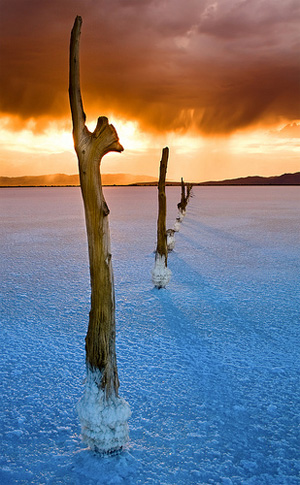What is exposure? In photography, it simply means the amount of light to which the film or sensor has been exposed. The next question is how do we control the exposure? The shutter speed is one factor, the aperture setting is another factor. These two controls affect the camera in the following ways.

“lines racing thru my mind” captured by Great Salt Lake Photographer (Click Image to See More)
Aperture
Aperture is a variable circular opening that changes in size depending on the setting you use. If the opening is large, it lets a lot of light into the camera. If the opening is small, it only lets a small amount of light into the camera.
The day is dark, cloudy and overcast. You need a lot of light. A low setting of f/2.8 lets a lot of light into the camera.
The day is very bright and sunny, you need to provide less light. You need to use a higher f-stop to decrease the amount of light. A high setting of f/22 lets only a little light into the camera.
Shutter Speed
Shutter speed also helps you control exposure. A slow shutter speed lets more light into the camera because the shutter is open longer. A slow shutter speed will not stop motion. This can become a problem. A fast shutter speed will stop motion. A fast shutter speed allows less light in the camera because the shutter in open a shorter time. It has become a convention to use blurring as a way to convey motion visually, and also have it provide an emotional impact. This is a creative use of shutter speed to give the viewer an emotional and visual feel of motion.
This brings us to the terms over-exposed and under-exposed. Over-exposed means the picture had too much light. Under-exposed means the picture had too little light.
The use of light and shadow or light and dark can be used creatively to bring about various emotions.

“Into the Light” captured by Luis A. De Jesus (Click Image to See More From Luis A. De Jesus)
The creative use of the two variables—aperture setting and shutter speed—gives us a way to produce artistic freedom and impart emotion and feeling. The controls require us to make choices and experiment with settings but they provide artistic liberty as we build our body of experience and knowledge.
ISO
There is a third variable that we have to consider. When we work with film we have to utilize a film that will best suit our purpose. Film can be expensive. Color or black and white. Film speed. Now that we use memory cards we have to deal with the cybernetic equivalent of film speed. The major advantage is we can transfer our picture files to our personal computer. If we have three or four memory cards. We can use them again and again. We don’t need to purchase a new roll of film when we want to take pictures.
Film could be slow speed, medium speed or fast speed. The ISO setting on your camera provides you with this capability you could change the ISO setting with every picture if it is necessary. The following are common ISO settings.
- ISO 100 slow fine-grained produces best quality pictures
- ISO 200 slow produces excellent quality
- ISO 400 medium all purpose good quality
- ISO 800 Medium-fast all purpose, good quality, low light stop motion
- ISO 1600 very fast night use, low light, freeze frame
These three factors control exposure. Experiment with the settings.

“Light & Shadow” captured by SAM Nasim
Ask yourself questions. Is my optimal setting the best picture? Are there some settings that produce a better picture than the optimal setting? By analyzing and criticizing this work, you have increased you body of experience and photographic knowledge. Criticizing your work is how you grow creatively. Experimentation has great value in developing our visual skills. You are developing insight and creative judgment not just memorizing a formula.
Like This Article?
Don't Miss The Next One!
Join over 100,000 photographers of all experience levels who receive our free photography tips and articles to stay current:






Leave a Reply